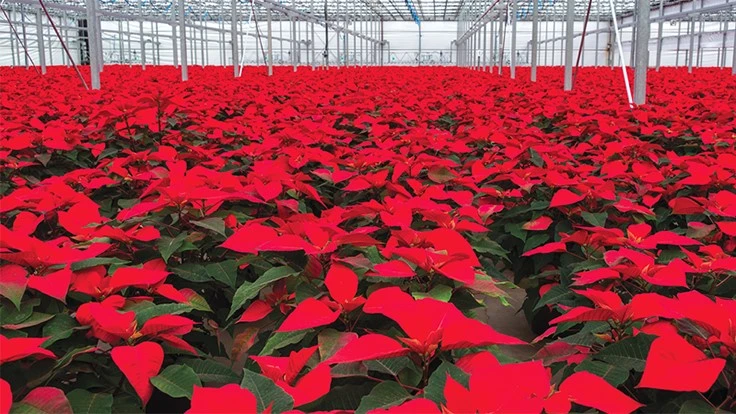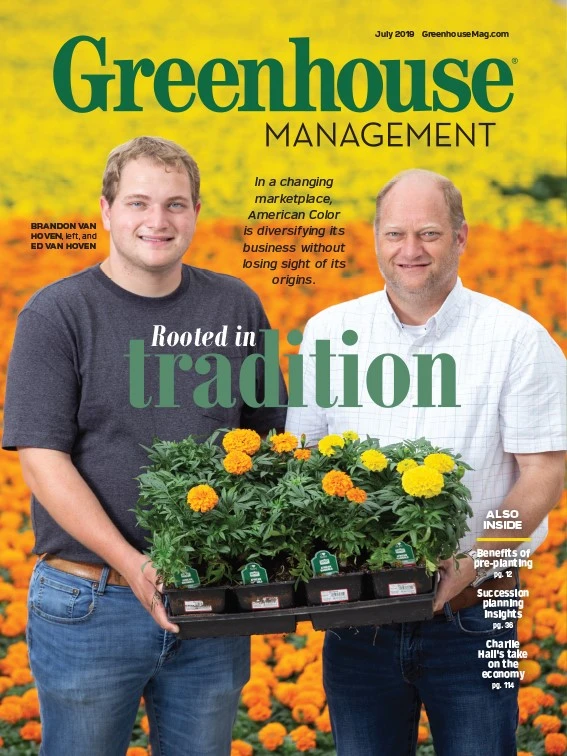

Whiteflies and thrips remain two of the most challenging pests in ornamental production. There are multiple species of each, some of which can transmit plant viruses, leading to further plant damage. Preventing these insect pests is critical for optimal control. Curative applications can be costly and unsuccessful.
The biggest reason whiteflies and thrips are so difficult to control is their rapid reproduction rate. Populations of these two pests can increase very quickly, often resulting in plant injury. To make matters worse, their prevalence has led to resistance issues.
“They hit so many different crops and the reproduction is so rapid so they’re being treated very often, which can lead to resistance to the materials that everyone is using,” says Stanton Gill, extension specialist in IPM and entomology at the University of Maryland Extension. “Growers who are doing broad-spectrum spraying in a greenhouse environment and trying to hit multiple plants in multiple applications — you’re going to get resistance. Especially with thrips, because their life cycle is so short.”

Whiteflies’ life cycle moves a little slower than thrips, taking 24 to 26 days for a complete pass through from egg to reproducing adult. Controlling whiteflies and thrips requires an integrated strategy of monitoring, utilizing proper cultural practices and effective control agents. Since they often feed in hard-to-reach areas of the plant (buds and flowers), thorough application coverage is critical for successful control. Thrips make it particularly difficult because of their egg-laying practices.
“The egg is tucked into the leaf so the grower can’t see it,” Gill says. “It hatches, it goes through two larval stages than boom – it’s an adult reproducing. That can be very rapid when the hot weather occurs. So populations can go through the roof quickly.”
In addition to the potential threat of tospovirus transmission with thrips, their rasping mouthparts cause physical injury to both leaves and flowers, reducing the quality and salability of the crop. With whiteflies, the presence of immatures and adults is not appealing, and the sticky honeydew they excrete attracts ants and results in the growth of sooty mold.
“It is important to carefully scout your crops every week and apply controls at the first appearance of the pest,” says Nancy Rechcigl, technical services manager for ornamentals at Syngenta.
Being proactive can help with control, and big-ticket crops like poinsettia and basil are priorities because they’re such moneymakers.
“Poinsettia is always going to be the classic plant they go to,” Gill says. “Gerbera daisy is the Typhoid Mary of plants — gorgeous flower, but it gets whiteflies, it gets thrips, it gets aphids, it gets powdery mildew, downy mildew, it gets it all.”
Amy Morris, head grower at N.G. Heimos Greenhouses in Milstadt, Ill., was spending a lot of time and product spraying for pests. She turned to Mainspring® GNL insecticide from Syngenta, which is a neonicotinoid alternative for greenhouse and nursery crops.
“We trialed Mainspring GNL and found that a drench provided excellent coverage,” Morris says. “We were not seeing any caterpillars, thrips, aphids or leafminers. We used to have to spray every week just to prevent flare ups of aphids or caterpillars on our outdoor mums but we’re able to eliminate a lot of that product use with a drench of Mainspring GNL.”

A safer alternative
Neonicotinoids have long been used to combat infestations in the nursery. However, recent bans and limitations have forced growers to consider alternative chemistries. Mainspring GNL insecticide controls a wide range of chewing and sucking pests with the novel active ingredient cyantraniliprole, which belongs to the recently-added chemistry class (IRAC Group 28). As a non-neonicotinoid product, it is compatible with beneficial insects. It carries a four-hour REI (restricted-entry interval), has no special personal protective equipment required for early entry and is registered by the U.S. EPA under its Reduced Risk Program.
A reduced risk pesticide use is defined as one which may reasonably be expected to accomplish one or more of the following; (1) reduces pesticide risks to human health; (2) reduces pesticide risks to non-target organisms; (3) reduces the potential for contamination of valued, environmental resources, or (4) broadens adoption of IPM or makes it more effective. Mainspring GNL qualifies under one or more of the above criteria.
When used preventively, Mainspring GNL, can keep pest populations from building to damaging levels and helps reduce additional pest pressure later in the season, Rechcigl says.Growers can use Mainspring GNL in a similar manner as they would a neonicotinoid product.
“Mainspring GNL is systemic, so you should make a drench application a few weeks after transplanting, once the crop has started rooting into the container,” says Rechcigl. “The more roots that are present, the more active ingredient is picked up, resulting in longer control. You typically see 8-12 weeks of protection with drench applications.”
Sprays can also be used to control these pests on crops with short production times. When sprayed, applications should begin when insect populations are first noticed. The active ingredient will be absorbed into the plant tissue and prevent populations from building to damaging levels. Spray applications also have residual activity and Rechcigl recommends making applications on a two-week interval.
Morris was pleased with the results of the Mainspring GNL drench on her poinsettia crop.
“We appreciate that we are using fewer chemicals on a weekly basis and the fact that it is not a neonicotinoid,” she says. “With poinsettias, we found that drenching them at the 10 oz. rate held perfectly for 8 weeks. If we want 100% coverage, we drench with Mainspring GNL and we don’t have to go back and make curative applications. I would absolutely recommend it to other growers.”

A potent combo
Using a product rotation with different modes of action is an important component of an integrated pest management (IPM) program to help prevent the development of resistance. Growers should select products with/from different FRAC and IRAC codes and, if using biological control agents (BCAs), ensure compatibility. For the greatest success, take time to research the control products and the BCAs in your IPM program to ensure compatibility and avoid trial and error.
“Mainspring GNL works like a shield and provides long, residual control against a wide range of chewing and sucking pests that challenge ornamental production,” Rechcigl says. “It also has good compatibility with natural enemies/beneficials and can be used in IPM programs. Having an effective tool that will control your primary pest problems with long residual control means that the grower has more time to focus their attention on other productions issues.”
Gill has long been a proponent for biological control programs for thrips and whiteflies because of the resistance issue.
He has conducted many trials testing IPM approaches that incorporate traditional chemical treatments. During a 2018 trial focused on eliminating thrips and aphids from dahlias, he found an approach that works well. On the chemical side, he used a drench with Mainspring GNL applied twice a year at a rate of 8 oz. per 100 gallons of water. He combined that with a banker plant system, predacious insects and pheromone and food-baited sticky traps.
The banker plants used in the Maryland trial were an ornamental pepper (Capsicum annuum) ‘Purple Flash’, which was chosen for prolific flower production. The peppers’ job was to provide pollen and nectar to feed a predacious insect called Orius (also known as minute pirate bugs), which loves to feed on the larval stage of thrips.
“When used preventively, Mainspring GNL can keep pest populations from building to damaging levels.” NANCY RECHCIGL, technical services manager, ornamentals, Syngenta
The compatibility of Mainspring GNL with beneficials came in handy, as he also used two predatory mites, Amblyseius cucumeris and A. swirskii, in the trial.
Gill says the drench did an excellent job controlling aphids on the treated plants for the entire season. No aphids or thrips were detected in the first 12 weeks of growth. And its application did not impact predator releases.
“It worked beautifully,” Gill says.
Next, he’s planning a second year of the project, in which he’ll reduce the number of biological releases to try to reduce the cost per plant.
In addition to whiteflies and thrips, Mainspring GNL can be used to prevent aphids, caterpillars, leafminers, leaf-feeding beetles and lace bugs for greenhouse and nursery growers.
Learn more at GreenCastOnline.com/MainspringGNL

Explore the July 2019 Issue
Check out more from this issue and find your next story to read.
Latest from Greenhouse Management
- Anthura acquires Bromelia assets from Corn. Bak in Netherlands
- Top 10 stories for National Poinsettia Day
- Langendoen Mechanical hosts open house to showcase new greenhouse build
- Conor Foy joins EHR's national sales team
- Pantone announces its 2026 Color of the Year
- Syngenta granted federal registration for Trefinti nematicide/fungicide in ornamental market
- A legacy of influence
- HILA 2025 video highlights: John Gaydos of Proven Winners





